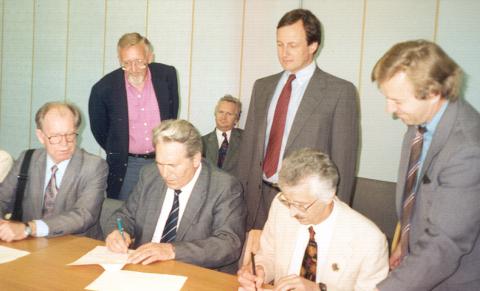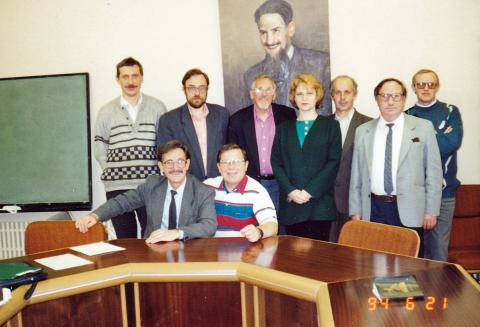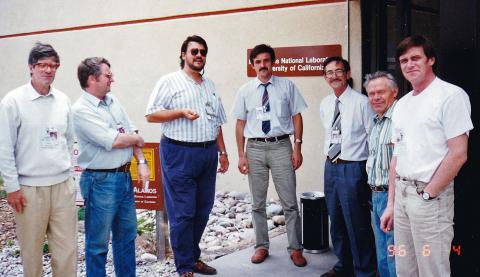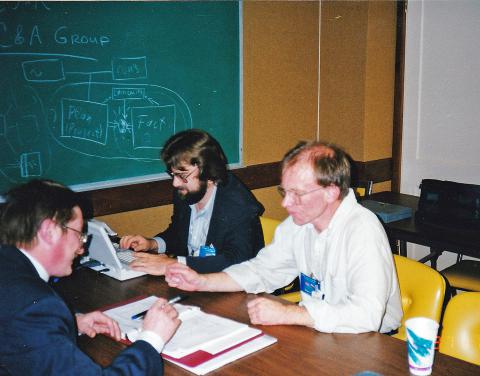Lab-to-Lab: US-Russian Lab-to-Lab Collaboration Story [Archived]
- Home
- Joint Verification Experiment
- Science Collaboration
- Nuclear Materials
- Nuclear Weapons
- Nuclear Experts
- What’s New
Nuclear materials protection, control, and accounting (MPC&A) was a highly successful field of the lab-to-lab cooperation. Even though in 1993 the Department of Defense (DoD) and Minatom signed a MPC&A agreement, the governmental initiative was making very little progress until the DOE, upon insistence from the labs, opened the door to a lab-to-lab approach. The incoming DOE Under Secretary Charles B. Curtis in April 1994 provided seed funds to initiate concrete collaboration in fissile materials protection. Much of the progress in MPC&A cooperation was made during the first four years, the time of close partnership between Curtis at DOE and the laboratories.

VNIIEF Director Vladimir Belugin and LANL Director Sig Hecker sign first MPC&A contracts. June 1994. Seated at the table on the left, Ilkaev; seated at the back, Selemir. Standing, from the left, Augustson and Mullen. First MPC&A contracts signed in VNIITF 1994. VNIITF Scientific Director Evgeny Avrorin and LANL Director Sig Hecker sign first MPC&A contracts. June 1994. First MPC&A contracts signed in Kurchatov Institute 1994. Kurchatov Institute Director Nikolai Ponomarev-Stepnoy and LANL Director Sig Hecker sign first MPC&A contracts.
Two projects initiated in the summer of 1994 had an especially significant early impact on the subsequent growth of the lab-to-lab MPC&A program. One was MPC&A upgrades of “Building 116” at the Kurchatov Institute in Moscow and another was the demonstration of a model MPC&A system developed by VNIIEF. VNIIEF showcased the model system in spring of 1995 to a broad cross-section of Russian nuclear facilities and organizations, including Minister Mikhailov. Mikhailov was so impressed that he ordered the entire demonstration moved in May 1995 to his office in Minatom Headquarters in Moscow. There, it was shown to numerous Russian government officials, managers, and technical experts from Minatom’s nuclear enterprises and institutes, as well as to news media and foreign visitors. The demonstrations received highly favorable reactions both from government officials and from the nuclear facilities, and served to greatly strengthen support for expanding MPC&A cooperation within the Minatom complex.
This initial lab-to-lab effort evolved into a multifaceted laboratory and governmental program that over 20 years, supported by roughly $4 billion of DOE funding, helped Russia develop a modern MPC&A system and has strengthened MPC&A systems at hundreds of locations encompassing hundreds of tons of fissile materials.
Much of this continued improvement resulted from the efforts of the Russian nuclear specialists and the injection of funds from the Russian government. Through international programs, Russian experts became closely integrated into the international fabric of nuclear materials security experts and organizations. During the years, hundreds of them participated in the annual Institute for Nuclear Materials Management conferences in the United States, and some 10,000 specialists and practitioners participated in training courses taught by both US and Russian experts.
This collaboration was successful because the program was closely aligned with the national interests of both countries; it addressed important issues of global concern, that is, risks of nuclear proliferation and nuclear terrorism; and it consistently produced tangible results over an extended time.

VNIIEF scientists and Ron Augustson, under the portrait of Igor V Kurchatov, after a long day of negotiations. Sarov,June 1994.
The Russian government served notice in 2013 that it considered the cooperative efforts at its own facilities essentially complete. In December 2014 it formally declared the termination of the MPC&A cooperative program.
In the words of participants
On behalf of my VNIITF colleagues, who collaborated in the Russian-American MPC&A program, I would like to express a heartfelt gratitude to the US colleagues for the fruitful joint work we conducted over many years. I believe that our collaborative efforts on improving the accounting, physical protection, control, and culture of handling nuclear materials have contributed to strengthening the nonproliferation regime in Russia, helped strengthen Russia’s security, and hence the stability in the world. The long experience of this collaboration shows that in the presence of normal state-to-state relations we can build mutually beneficial cooperation and trust between the participants.
Yuri Churikov, VNIITF
The accumulated experience of 22 years of our collaboration must be used for the mutual benefit of both parties. The most obvious application of this experience can be the provision of assistance to third countries in improving the security of nuclear materials and facilities. The combined intellectual potential of the Russian and American specialists can be used with high efficiency, both in the efforts to improve MPC&A technology and in resolving the common problems of supporting non-proliferation and combating nuclear terrorism.
Gennady Pshakin, IPPE

Break chat during MPC&A workshop in LANL. From left to right, Vatulin, Mikiychuk, Kutyreff, Maltsev, Skripka, Kuvshinov, Khlystov
Find it in the book
Chapter 4 of Volume I contains in-depth accounts and reflections by Mark F. Mullen (LANL), Vladimir I. Yuferev and Georgy M. Skripka (VNIIEF), Yuferev et al. (VNIIEF), Yuri I. Churikov (VNIITF), Leonid A. Kochankov and Alexander S. Lavrentiev (VNIIEF), Andrey S. Sviridov (VNIIA), Gennady M. Pshakin (IPPE), Nikolai N. Ponomarev-Stepnoy (Kurchatov Institute), Vladimir I. Yuferev and F. Jeffrey Martin (VNIIEF-LANL).

Russian and American experts work out the parameters of a joint project. 1997
Documents
1999 MPC&A Agreement – Agreement Between the Government of the United States of America and the Government of the Russian Federation Regarding Cooperation in the Area of Nuclear Material Physical Protection, Control, and Accounting.
2 October 1999
